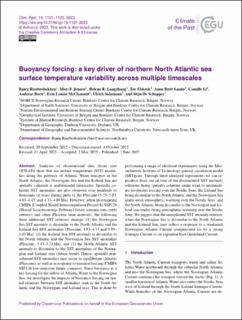| dc.description.abstract | Analyses of observational data (from year 1870 AD) show that sea surface temperature (SST) anomalies along the pathway of Atlantic Water transport in the North Atlantic, the Norwegian Sea and the Iceland Sea are spatially coherent at multidecadal timescales. Spatially coherent SST anomalies are also observed over hundreds of thousands of years during parts of the Pliocene (5.23–5.03, 4.63–4.43, and 4.33–4.03 Ma). However, when investigating CMIP6 (Coupled Model Intercomparison Project 6) SSP126 (Shared Socioeconomic Pathway) future scenario runs (next century) and other Pliocene time intervals, the following three additional SST relations emerge: (1) the Norwegian Sea SST anomaly is dissimilar to the North Atlantic and the Iceland Sea SST anomalies (Pliocene; 4.93–4.73 and 3.93–3.63 Ma), (2) the Iceland Sea SST anomaly is dissimilar to the North Atlantic and the Norwegian Sea SST anomalies (Pliocene; 3.43–3.23 Ma), and (3) the North Atlantic SST anomaly is dissimilar to the SST anomalies of the Norwegian and Iceland seas (future trend). Hence, spatially non-coherent SST anomalies may occur in equilibrium climates (Pliocene), as well as in response to transient forcing (CMIP6 SSP126 low-emission future scenario). Since buoyancy is a key forcing for the inflow of Atlantic Water to the Norwegian Sea, we investigate the impacts of buoyancy forcing on spatial relations between SST anomalies seen in the North Atlantic and the Norwegian and Iceland seas. This is done by performing a range of idealized experiments using the Massachusetts Institute of Technology general circulation model (MITgcm). Through these idealized experiments we can reproduce three out of four of the documented SST anomaly relations: being spatially coherent under weak to intermediate freshwater forcing over the Nordic Seas, the Iceland Sea being dissimilar to the North Atlantic and the Norwegian Sea under weak atmospheric warming over the Nordic Seas, and the North Atlantic being dissimilar to the Norwegian and Iceland seas under strong atmospheric warming over the Nordic Seas. We suggest that the unexplained SST anomaly relation, when the Norwegian Sea is dissimilar to the North Atlantic and the Iceland Sea, may reflect a response to a weakened Norwegian Atlantic Current compensated for by a strong Irminger Current or an expanded East Greenland Current. | en_US |
